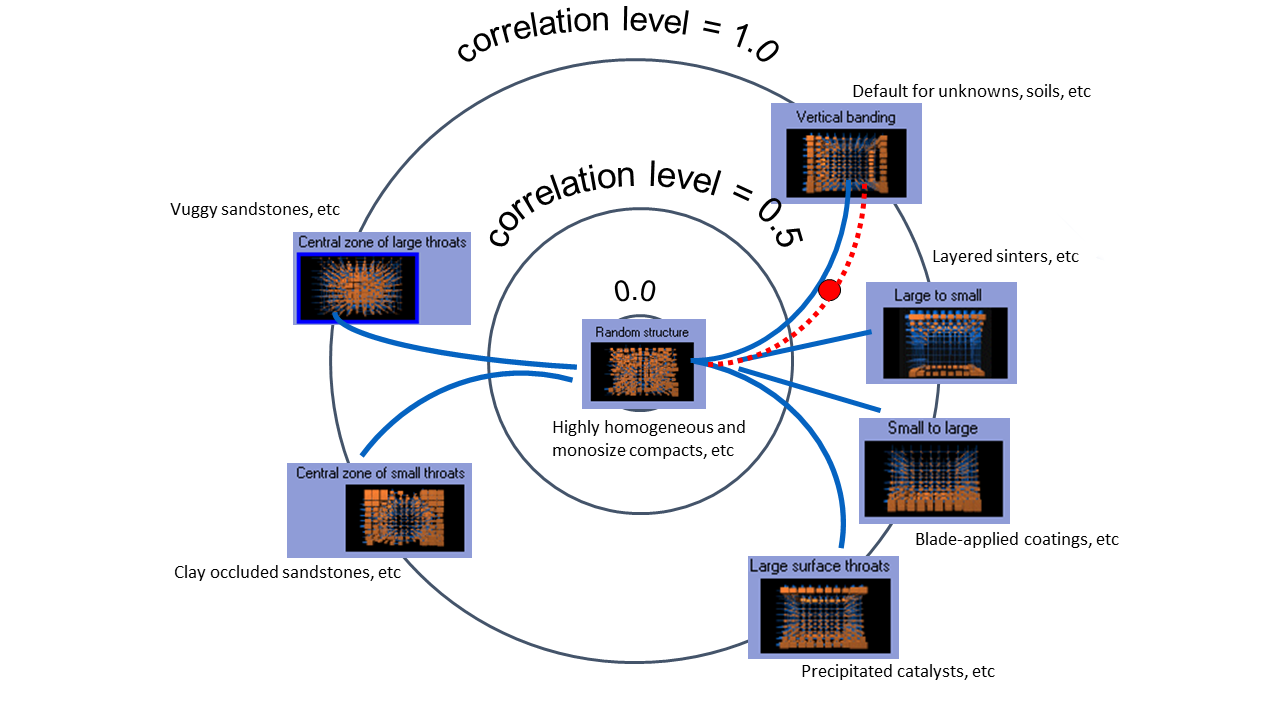Basis of the Simplex fitting
Void network structures are generated by the PoreXpert simplex which have the closest match to the experimental percolation curve of your sample. The fitting process is undertaken using an annealed simplex algorithm, which works to find the global minimum by varying five parameters.
These five parameters, together with the porosity, minimum and maximum void sizes, are used to generate a unit cell. A unit cell is a 3-dimensional representation of a void network. Examples are given in the following pages. To allow the user to see the layout of the whole void network, rather than simply the surface of the porous medium as seen under a microscope, the solid phase is shown transparent and the voids as solid. Voids that are probably clusters of smaller voids are shown stippled / rendered. For simplicity, PoreXpert spaces the void features equidistantly in each direction, although in practice smaller features are likely to be more closely spaced. The unit cells have periodic boundary conditions - i.e they are connected to replicates of themselves in every Cartesian direction, and any fluid which escapes from a surface of the unit cell enters the connecting face of the replicate. All fluids are intruded or permeated from the top (maximum z) surface of the unit cell, as shown for vertical banded structures overleaf.
To simulate the percolation, a computational representation of a non-wetting fluid (such as mercury displacing nominal vacuum or air displacing water) is applied to this top (maximum z) face of the unit cell only, and percolates in the –z direction. A Boltzmann-annealed amoeboid simplex (Press and Teukolsky, 1991, Johnson et al., 2003) varies five parameters (throat skew, throat spread, pore skew, connectivity and short range size auto-correlation level) to give the closest fit to the entire percolation curve. For simplicity we refer to the short range pore-throat size auto-correlation level simply as correlation level. There are three additional Boolean constraints on the simplex: it rejects structures in which the network is fragmented, in which voids overlap, or which cannot be adjusted to give the experimental porosity without contradicting the experimental percolation characteristics.
Choice of structure type and correlation level
A PoreXpert structure type is a class of short-range size auto-correlation locus. The various structure types are shown in the figure below, together with the examples of sample types each structure type applies to. You may think that the selection of structure types is rather arbitrary - but in practice there is usually one of them that fits a particular sample. And remember that the structure type is only one of five parameters that the simplex is fitting.

In practice, it is usually impossible to know what structure type is applicable to a natural sample, remembering that the pore-throat size auto-correlation level is at a very small scale - that of the spacing between rows of features in PoreXpert (the 'pore row spacing'). That spacing is set to be something a little above the largest void size, its exact dimensions depending on the porosity of your sample (the lower the porosity, the higher the spacing between pores).
So the standard approach is to try all the different structure types, and find out which provides the best fit (lowest Distance) to your experimental measurements -see our Property Validation exercise for a specific example. The Distance needs to below 2%, and preferably below 1% for the fit to be valid. This is most conveniently done by defining a Batch, and leaving the model for a while - possibly up to several hours, to make the calculation.
For each of the structure types, the simplex can choose a correlation level anywhere between 0.0 (a random structure) and 1.0 (a fully correlated structure). So, for example, if a Vertically Banded structure is tried, the simplex moves along the red dotted path shown in the diagram above.
When you have found the best structure type (smallest fit Distance), then look back at the diagram and check that you think it is appropriate for your sample. If two structure types have similarly small fit Distances, and both seems possibly appropriate for your sample, then we suggest you use both, and compare the results of the simulations. Specifically, if a Vertically Banded structure type fits, and also one of the Horizontally banded structure types, then you can use them as bounds for the network permeability simulation - the vertically banded structure will give an upper bound, and the horizontally banded structure a lower bound.
If no structure type fits, then try using different stochastic generations.
Examples of the various structure types are described in the following sections. Note that it is the pore-throats that are correlated, not the pores. Every pore is at least as large as any of the throats entering it, so the pore sizes are also positionally correlated, but to a lesser extent than the throats. All the examples have low porosity, so that the features are spaced out and can be seen individually. For very large and/or medium to high porosity unit cells, the pore-throats may be masked by the pores.
In all unit cells, the solid phase is shown transparent, and the voids as solid - allowing examination of the entire void network architecture by virtual reality. All the structures are arranged so that they fit with their replicate unit cells in every Cartesian direction.